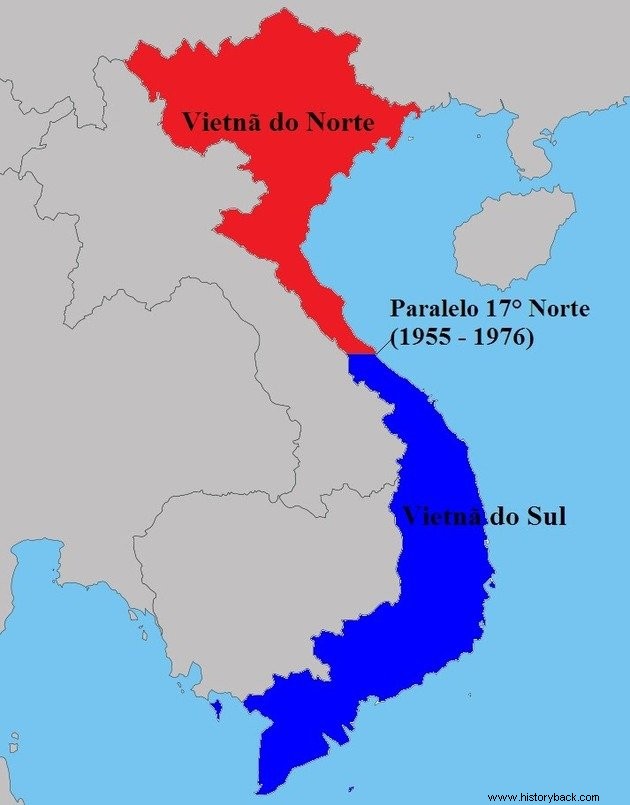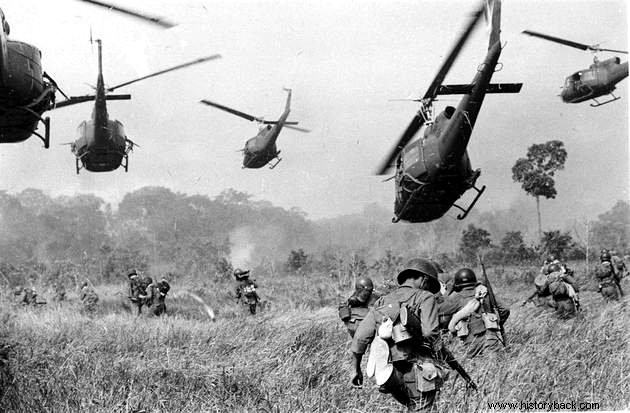The Vietnam War , which took place between 1955 and 1975, was a conflict between the United States and North Vietnam, the latter supported by the Soviet Union.
Combat is part of the context of the Cold War, when the United States and the Soviet Union did not face each other directly, but intervened in territories that could become future allies.
Combatants of the Vietnam War
With a strong ideological motivation, the war represented the military confrontation between capitalism and socialism. Likewise, it spread through much of Southeast Asia between 1955 and 1975, reaching Laos and Cambodia.
Let's look at the two sides that fought:
- Capitalists :Republic of Vietnam (South Vietnam), ruled by dictator Ngo Dinh-Diem. Supported by the United States, Australia, New Zealand and South Korea.
- Socialists :Democratic Republic of Vietnam (North Vietnam), ruled by Ho Chi Minh. It had as allies the National Front for the Liberation of Vietnam (FNL) in the south of the country, the Soviet Union, China and North Korea.
Vietnam War Summary

From Indochina to Vietnam
The territory that comprised Vietnam was part of Indochina, a French colony since the 18th century.
However, in 1930 the League for the Independence of Vietnam was created. (1930), led by Ho Chi Minh (1890-1969). With the beginning of World War II, the Japanese invade the territory and France sees its influence diminish.
At the end of the international conflict, France regained Indochina, but the desire for local independence was stronger.
In this way, French and independentists face each other during eight years of wars. Only in the 1950s did they withdraw from the area. In 1954, they sign the Geneva Agreement, which creates four distinct countries:Cambodia, Laos, North Vietnam (communist) and South Vietnam (capitalist).
North Vietnam and South Vietnam
The government of North Vietnam has always expressed its desire to reunify the country's two territories and has promoted the Nationalist Front for the Liberation of South Vietnam .
To avoid a conflict, the population would decide through a plebiscite the direction of the unification of Vietnam in 1956. Everything indicated that this would be won by the communist faction.
Against this background, the US-backed Prime Minister Ngo Dinh Diem (1901-1963) carried out a military coup in 1955, provoking a civil war between the forces of the South and the North.
US entry into the Vietnam War
Later, in 1959, the Viet Cong and the regular North Vietnamese army attacked a US base in South Vietnam. Later, in 1963, Ngo Dinh Diem is assassinated.
Faced with this attack, President John Kennedy (1917-1963) begins to send the first troops to the country.
However, the United States was hesitant to engage in conflict in a region so far away after the American military failure during the Cuban Revolution.
In August 1964, however, the American secret services forge an incident between their ships and an alleged North Vietnamese vessel in the Gulf of Tonkin. This makes President Lyndon Johnson (1908-1973) send 500,000 troops to fight in the Asian country, despite not having the support of Congress to do so.
Tet Offensive
The "Tet Offensive" was an invasion from North Vietnam to South Vietnam. In this operation, the North Vietnamese army simultaneously attacks more than thirty cities in that territory, taking over the US embassy in Saigon.
This incursion humiliated the United States, which already had a contingent of more than 500,000 men in Vietnam.
Ho Chi Minh, communist leader, died in 1969, but the attacks of the North Vietnamese army continued until 1973. Pressured by public opinion and Congress, President Richard Nixon begins to withdraw American troops from the country and signs the Paris Agreement.
In 1976, the South is taken and Vietnam is unified under the name of the Socialist Republic of Vietnam.
Strategies in the Vietnam War

On the North American side, the main military strategy consisted of bombing with chemical weapons, including some banned by the Geneva Conventions. Napalm would be one of the symbols of this conflict.
In addition, to withstand the harsh conditions of battle, American soldiers were drugged with LSD and other substances.
The North Vietnamese and Viet Cong, on the other hand, practiced guerrilla tactics, including sabotage, traps and ambushes in the rear of the fighting fronts.
As they knew the terrain very well, they were able to take full advantage of the geographic advantages of the tropical forests of thicket.
Likewise, the motivation of each army weighed on the morale of the troops. While the Vietnamese were fighting for something concrete, the Americans were fighting for something distant like preventing the advance of communism.
These factors, associated with the North American antipathy among the Vietnamese, provoked by their military actions, culminated in the American defeat.
Vietnam War and the Media
The Vietnam War received extensive media coverage. These publicized worldwide atrocities such as attacks with chemical agents, the construction and incarceration in concentration camps, as well as the indiscriminate massacre of civilians.
This huge publicity surrounding the war, as well as the lack of international support for the victims of the conflict, led to the emergence of several peace movements.
In the United States, the return of mutilated and traumatized soldiers only reinforced the perception of American public opinion against the conflict.
Therefore, pacifist demonstrations took to the streets of the USA and other parts of the world. With protests, the crowds pressed to end the conflicts and withdraw the troops.
See also:Hippie MovementNumbers from the Vietnam War
Deadly casualties:
- 4 million Vietnamese,
- 2 million Cambodians and Laotians
- over 60,000 US troops.
An estimated 2 million Vietnamese fled to other countries.
In this campaign, more than 3 million US servicemen served in Vietnam. It is estimated that the military action cost more than 123 billion dollars, between war costs and investments in South Vietnam.
Movies about the Vietnam War
There are several American films that dealt with the Vietnam War. From those who exalted Americans with heroic characters like Rambo , by Sylvester Stallone or the Badrock , by Chuck Norris, to critics like Apocalypse Now .
Check the list:
- Apocalypse Now , 1979
- Hair , 1979
- Platoon , 1986
- Born to Kill , 1987
- Good morning, Vietnam, 1987
- Born on the 4th of July , 1989
- Air American , 1990
Curiosities
- Each country calls the war a different name. While in the United States the conflict is known as the Vietnam War, in the Asian country it is called the War of the United States.
- This was the longest and bloodiest armed conflict after World War II.
Read more :
- Missile Crisis
- Cold War
- Cold War Conflicts
